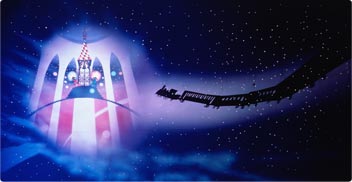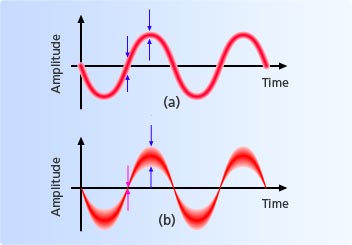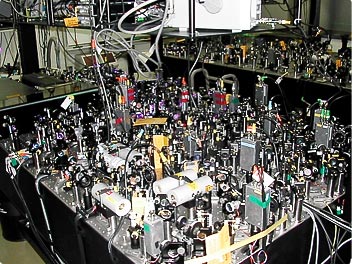The term “teleportation” is no longer confined to the world of science fiction. In 1998, Akira Furusawa (then a researcher at Nikon Corporation, now Associate Professor at the University of Tokyo) was a core member of the California Institute of Technology research group that first successfully achieved quantum teleportation. What was this quantum teleportation, which was realized using twin photons?
Twin stars
On the western edge of the Milky Way, two stars can be seen, as tiny as the spores of the field horsetail. There sits the small shrine of the water nymphs, where the twin stars Chunse and Pose dwell.
Thus begins “The Twin Stars,” the heart-warming Kenji Miyazawa's fairy tale so beloved by the Japanese. All night long the twin stars play along to the “Song of the Stars” on their silver flutes, as they have been commanded to do by the king. When an evil comet arrives, the twins join hands and resolve matters with their pure and kind hearts.

The Twin Stars by the shadow artist Seiji Fujishiro. A shadow picture based on Kenji Miyazawa's most famous story, “Night on the Galactic Railroad.”
The Twin Stars appear in other works as well.
©Seiji Fujishiro/HoriPro 2005
Kenji wrote “The Twin Stars,” his first fairy tale, at the age of 22, and read it to his family. The Twin Stars appeared in his later works “Night on the Galactic Railroad” and “Letter 4.” In “Letter 4”, there is a scene in which Chunse scoops up snow and makes Pose eat it, reminiscent of when Kenji scooped up snow for his dying little sister Toshi to eat. Kenji likened himself and his beloved sister to the Twin Stars—He may have wanted to forge a special link between the wondrous fate of the twins and that of himself and his sister.
Likewise, there are special inseparable bonds in the quantum world. One such example is the mutual influence that two particles of light born at the same time (twin photons) have on each other's destiny. It is impossible to explain these twin photons other than in terms of their mutual dependence. On the strength of this special relationship, twin photons make quantum teleportation possible.
The genius' mistake—the EPR paradox
The unbreakable relationship between twin photons is known as “entanglement.” When two photons are in a state of entanglement, the state of one photon is determined by the state of the other. In this amazing relationship the two particles influence each other's destiny—even if they are tens of thousands of kilometers apart. Entanglement is the key to realizing quantum teleportation.
In order to understand entanglement, let us consider the example of two entangled electrons born simultaneously.
The states of two electrons can either be A (spin-up) or B (spin-down). Whichever one is A, the other will be B. However, until at least one of them is observed, the state of each electron is unknown.
Now suppose that one of the electrons is observed and is found to be in state A. Thus, the other electron's state is determined as B at the very instant the observation takes place, no matter how far apart the two electrons are.
The amazing behavior of entangled electrons can be explained using “Uncertainty Principle*1”—part of the discipline of quantum mechanics. However, 20th-century genius Albert Einstein was skeptical about quantum mechanics, as it seems to imply that information is transmitted to the other (far distant) electron of the pair instantaneously—that is, faster than the speed of light. He believed that it would be determined at the instant of their creation which electron would be A and which would be B. This proposition was named the EPR Paradox, taking its initials from the names Einstein, Podolsky, and Rosen. This proposition stood in forthright opposition to quantum mechanics.
- *1A fundamental view of quantum mechanics is that until a property of a photon or electron is actually observed, only the probability of the particle having that property can be known. Thus, it is impossible to simultaneously know the position and momentum of an electron within an atom. For example, if its location is observed, it is impossible to know its exact speed—only the range of possible locations within which its speed lies.
Are the states fixed to A or B in advance as Einstein contended? For a time, no suggestions were made about how it could actually be verified whose verdict was correct—Einstein's or that of quantum mechanics. In the 1960s, John Bell, a renowned Irish physicist, put forward a proposal for a groundbreaking method to investigate this question.
It was a difficult experiment. However, a successful experiment using photons was finally performed in the 1980s, and the results showed a victory for quantum mechanics! The amazing relationship of entanglement really does occur and Einstein was mistaken. The paradox was solved. With this realization, physicists realized that quantum teleportation might be possible, and if so would open the door to tremendous advances in computer science.
The EPR Paradox explained
Quantum teleportation of light
Let us see then how current quantum teleportation is realized.
Quantum teleportation involves the transmission of information to a remote location using quanta such as photons. Although information is transmitted, it is very different from fax or e-mail in that the original is not retained. Suppose that in the future humans are able to perform teleportation using this method. A person's body will be transformed into scattered particles for teleportation, and the observed state describing the body will be transmitted to a remote location. The body will then be reconstituted and rematerialize using matter at the destination location. At this juncture, nothing will remain at the place of origin. It should be noted that in this sense there are a number of differences from magic cartoon gateways or teleportation in science fiction, whereby people are instantly transferred bodily to a different location.
In 1993, a method for realizing quantum teleportation was proposed, and in 1998 human beings finally succeeded in realizing it. Of the four groups that issued reports on quantum teleportation, the research group led by Furusawa attracted particular attention. Prior experiments had only succeeded in partially transmitting information; however, the paper published by Furusawa's group announced a fidelity*2 figure of 0.58 (if quantum teleportation does not take place, this figure does not exceed 0.5). Thus, the Furusawa group was the first group to successfully complete quantum teleportation.
- *2Fidelity: A figure expressing the degree to which the information that was input was reproduced.
This result was greeted with astonishment, and the magazine Science listed the successful completion of quantum teleportation as one of the Top Ten breakthroughs of 1998.
Scheme for transmitting information to a remote location using quantum teleportation. By convention, the transmitter is called Alice, the receiver Bob, and a third party (if any) Claire, corresponding to the initials A, B, and C.
Toward a quantum teleportation network
The advantage that the Furusawa group enjoys is that their twin photons are of high quality. When a strong light is beamed at a crystal, one photon yields entangled twin photons with half the energy of the photon. The twin photons created by the Furusawa group have extremely low interference.
This concentration of photons is known as squeezed light. A section of the light wave is compressed with a high degree of precision, as if it had been squeezed (see left-hand diagram). If one section is compressed, the precision of other sections will deteriorate, in accordance with the principles of quantum mechanics. However, using only the compressed section allows the creation of entangled photons with little interference. Due to the cumulative effect of this refinement, a fidelity of over 0.7 was achieved.

(a) Ordinary light (b) Squeezed light
The position of each half wavelength can be determined with a high degree of precision. High-quality entangled photons can be obtained using this squeezed section.
Research into quantum teleportation has been progressing rapidly over the past few years. In 2004, quantum teleportation entered a new phase with the use of triplet photons transmitted to Alice, Bob and now Claire, enabling three-way quantum teleportation.
In historical terms as well, this is a landmark development, says Associate Professor Furusawa. The potential for three-way teleportation has a completely different significance to the potential for two way teleportation. Once three-way teleportation is possible, it is easy to expand it to four- and five-way teleportation. In other words, quantum teleportation to anywhere becomes possible. It is akin to the evolution from the two-way telephone to the multi-user Internet.

With light passing through a closely spaced alignment of small lenses, quantum teleportation experiments are carried out.
In the Furusawa research group's laboratory at the University of Tokyo, an alignment of small closely spaced lenses sits on a table about five square meters in area. The complex array of lenses adjusted to micron-level precision attests to the sophistication of the experiments. Associate Professor Furusawa remarked that these experiments are well suited to the serious and meticulous Japanese character, “requiring great determination to bring them to fruition.”
With an eye to the future, Associate Professor Furusawa says that his dream is “to freely manipulate the quantum state of light.”
While working for Nikon, conducting research on how to pack high volumes of information into memory, Furusawa realized that reading out data from memory takes an inordinately long time. The key to resolving this problem lies in the realm of quantum, and this has lent impetus to Associate Professor Furusawa's research. Followed to its logical conclusion, this idea brings one to the quantum computer—a completely new computer capable of performing vast calculations in an instant. Not only will this open up the world of quantum teleportation, but it will also be the key to realizing a new information society.
Editorial contributor / Date of article posted
Associate Professor Akira Furusawa, University of Tokyo / December 2006

